To access tea flavors at home, start with essential equipment like a temperature-controlled kettle, tasting cups, and a tea scale. Prepare your palate by avoiding strong flavors beforehand and cleansing with room temperature water. Understand the six main tea types and their characteristics. Master steeping techniques, adjusting time and temperature for each variety. Observe the tea's color and aroma, noting how they indicate oxidation levels. Learn to describe taste sensations, from basic categories to mouthfeel and aftertaste. Explore how terroir influences flavors, and experiment with food pairings. By following these essentials, you'll set out on a journey of sensory discovery.
Essential Tea Tasting Equipment
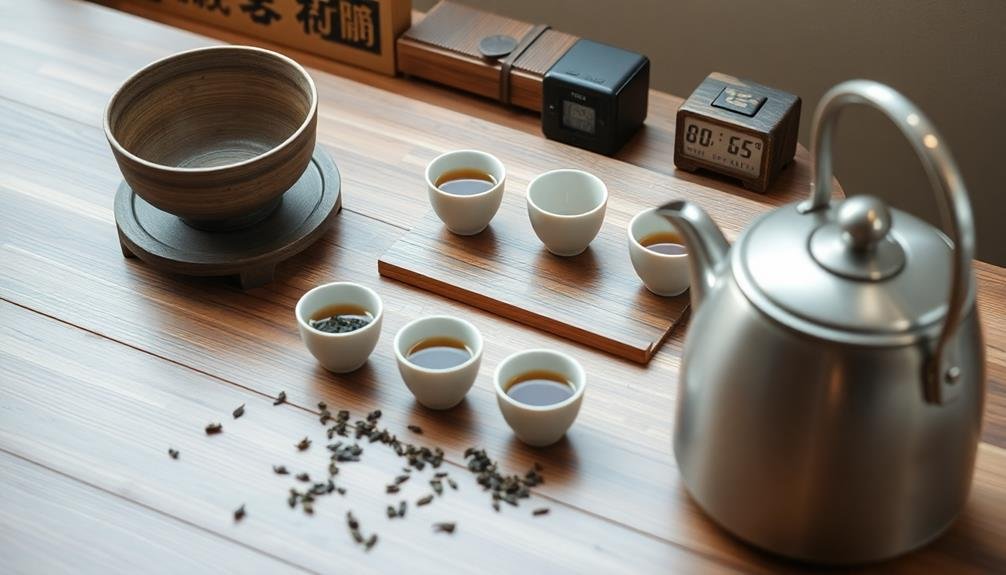
A well-stocked tea tasting kit is the foundation of any home tea enthusiast's journey. To get started, you'll need a few key items. First, invest in a quality electric kettle with temperature control. This allows you to heat water to the precise temperatures different teas require.
Next, acquire a set of small tasting cups or gaiwans, which are perfect for sampling multiple teas in one session. A tea scale is essential for measuring precise amounts of loose leaf tea, ensuring consistency in your brewing. Don't forget a timer to track steeping times accurately.
A strainer or infuser basket helps separate leaves from the liquid, while a tasting spoon lets you sample without burning your lips. For a more thorough setup, consider adding a sharing pitcher, also known as a fairness cup, to distribute tea evenly among multiple tasters.
A tea tray can contain spills and make cleanup easier. Finally, keep a notebook handy to record your observations, tasting notes, and brewing parameters. With these tools at your disposal, you're well-equipped to explore the vast world of tea flavors and aromas.
Preparing Your Palate
Preparation is key to a successful tea tasting experience. Before you engage in your tea journey, it's essential to prepare your palate. Start by avoiding strong flavors for at least an hour before tasting. This includes spicy foods, coffee, and mint, which can overpower your taste buds and affect your perception of the tea's subtleties.
Next, cleanse your palate with water at room temperature. Avoid ice-cold water, as it can numb your taste buds. If you're planning an extended tasting session, consider having some plain crackers or bread on hand to reset your palate between different teas.
To further enhance your tasting experience:
- Brush your teeth at least 30 minutes before tasting to remove any lingering flavors
- Avoid wearing strong perfumes or colognes that might interfere with the tea's aroma
- Stay hydrated throughout the day to keep your taste buds in peak condition
Understanding Tea Types
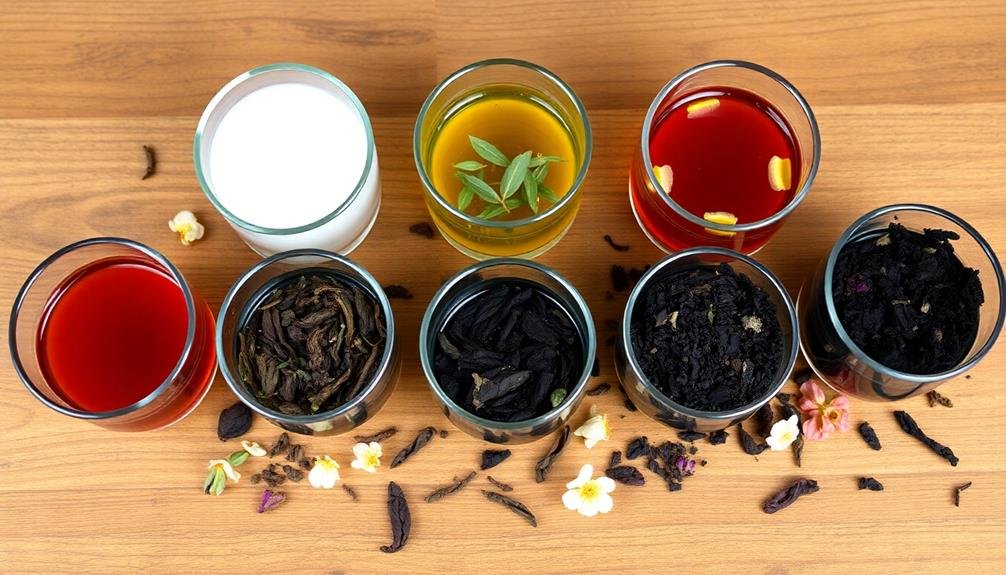
Diversity characterizes the world of tea, with countless varieties to explore. At its core, tea is divided into six main types: white, green, yellow, oolong, black, and pu-erh. Each type is distinguished by its processing method and oxidation level.
White tea is the least processed, retaining a delicate flavor. Green tea is unoxidized and often has a fresh, grassy taste. Yellow tea, rare and prized, undergoes a unique process that imparts a mellow flavor. Oolong teas are partially oxidized, resulting in a wide range of flavors from light and floral to rich and roasted. Black tea, fully oxidized, offers bold and robust flavors. Pu-erh, a fermented tea, develops complex, earthy notes over time.
Within these categories, you'll find numerous subtypes and blends. Factors like terroir, harvesting time, and processing techniques further influence a tea's character.
As you explore, you'll discover how each type's unique properties affect its aroma, taste, and mouthfeel. Understanding these differences will enhance your appreciation and guide your tasting journey.
Steeping Techniques for Optimal Flavor
Having explored the diverse world of tea types, let's turn our attention to the art of steeping. Proper steeping techniques are essential for revealing the full potential of your tea's flavor.
Start by using fresh, filtered water heated to the appropriate temperature for your chosen tea variety. Green and white teas typically require lower temperatures (160-185°F), while black and oolong teas need hotter water (190-212°F).
Measure your tea carefully, using about 1 teaspoon per 8 ounces of water for loose leaf tea, or follow the instructions on tea bags. Steep for the recommended time, which varies by tea type:
- Green tea: 1-3 minutes
- White tea: 1-5 minutes
- Black tea: 3-5 minutes
Avoid over-steeping, as it can lead to bitterness. Use a timer to maintain consistency.
For multiple infusions, increase steeping time slightly with each subsequent brew. Experiment with different steeping times to find your preferred flavor profile.
Observing Tea Color and Aroma
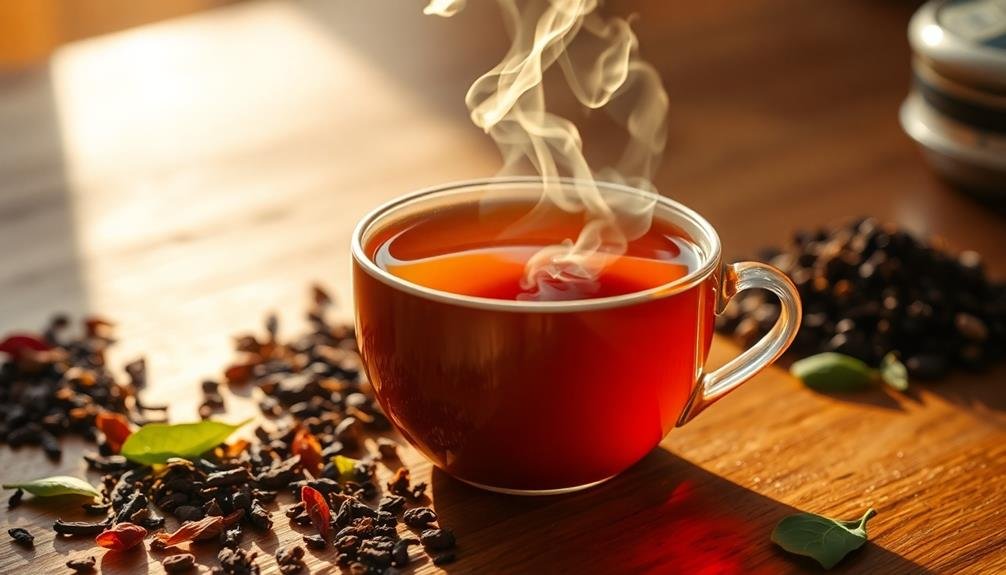
As you prepare to taste your tea, carefully observe its color and aroma. These visual and olfactory cues can reveal much about the tea's quality, processing, and potential flavor profile. Hold your cup up to the light and examine the liquor's hue. Is it pale gold, deep amber, or rich mahogany? The color often indicates the tea's oxidation level and brewing strength.
Next, bring the cup close to your nose and inhale deeply. Notice the different aromatics wafting from the tea. Are they floral, fruity, earthy, or grassy? The aroma can hint at the tea's flavor notes and overall character.
Here's a quick guide to common tea colors and their associated aromas:
| Tea Type | Color | Typical Aromas |
|---|---|---|
| Green | Pale green to yellow | Grassy, vegetal |
| White | Pale gold | Delicate, floral |
| Oolong | Amber to reddish-brown | Fruity, floral |
| Black | Deep red to brown | Malty, earthy |
| Pu-erh | Dark brown | Earthy, woody |
Describing Tea Taste Sensations
When you taste tea, you'll encounter various sensations that fall into basic taste categories like sweet, bitter, and umami.
Pay attention to the mouthfeel and texture, which can range from smooth to astringent.
Don't forget to contemplate the aroma and aftertaste, as they contribute considerably to the overall tasting experience.
Basic Taste Categories
Perception forms the foundation of our tea-tasting experience. As you explore different teas, you'll encounter a range of basic taste categories that help define each brew's unique profile. These fundamental tastes are essential to understanding and describing your tea experience.
The five primary taste categories you'll encounter in tea tasting are:
- Sweetness: Often associated with fruity or floral notes
- Bitterness: Common in strong black teas or over-steeped brews
- Umami: A savory, broth-like quality found in some green teas
You'll also notice secondary taste sensations like astringency, which creates a dry, puckering feeling in your mouth, and sourness, which can add brightness to certain teas.
As you develop your palate, you'll learn to identify these tastes and how they interact within each cup.
Mouthfeel and Texture
Beyond the basic taste categories, tea tasting involves exploring the physical sensations in your mouth. These sensations, known as mouthfeel and texture, play a significant role in your overall tea experience. As you sip, pay attention to how the tea feels on your tongue and throughout your mouth.
You'll encounter a range of textures, from smooth and silky to rough and astringent. Some teas may feel thick and creamy, while others are light and invigorating. Notice if the tea leaves a dry sensation, known as astringency, or if it's mouth-watering. The texture can also change as you swallow, with some teas leaving a lingering sensation.
To assess mouthfeel, take a small sip and let it coat your entire mouth before swallowing. Consider these aspects:
- Body: Is the tea light, medium, or full-bodied?
- Viscosity: Does it feel thin or thick?
- Astringency: Is there a drying sensation?
- Smoothness: How does it glide across your tongue?
- Finish: What sensations linger after swallowing?
Aroma and Aftertaste
Aroma and aftertaste are essential components of the tea tasting experience. As you prepare to evaluate these aspects, remember that your nose plays a significant role in detecting the tea's bouquet. Before sipping, inhale deeply from your cup to capture the initial scent. Note the intensity and any specific fragrances you perceive, such as floral, fruity, or earthy notes.
When tasting, pay attention to how the flavors evolve in your mouth. The aftertaste, or finish, is the lingering sensation after you've swallowed the tea. It can reveal subtle nuances that weren't immediately apparent. Consider the following:
- Duration: How long does the taste linger?
- Complexity: Do new flavors emerge over time?
- Pleasantness: Is the aftertaste enjoyable or off-putting?
To enhance your aroma and aftertaste evaluation, try "retronasal olfaction" by exhaling through your nose after swallowing. This technique allows you to detect additional aromatic compounds.
With practice, you'll develop a more refined palate and ability to discern the intricate flavors and aromas that make each tea unique. Remember, there's no right or wrong in taste perception – trust your senses and enjoy the journey of discovery.
Identifying Common Tea Flavor Notes
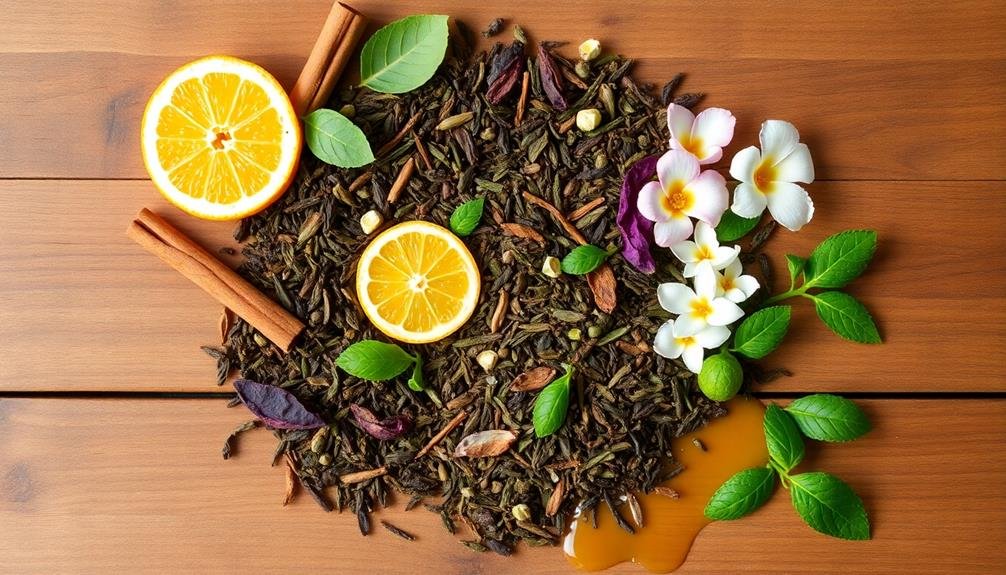
Identifying common tea flavor notes is an essential skill for any tea enthusiast. As you explore deeper into the world of tea tasting, you'll encounter a wide range of flavors that can be categorized into several groups.
For black teas, look for malty, smoky, or caramel notes. You might also detect hints of chocolate, leather, or dried fruit.
Green teas often exhibit grassy, vegetal, or seaweed-like flavors, with some varieties offering nutty or buttery undertones.
Oolong teas can range from floral and fruity to roasted and woody, depending on their oxidation level.
White teas typically present delicate, subtle notes of honey, melon, or fresh hay.
Pu-erh teas are known for their earthy, mushroom-like qualities, sometimes with a hint of camphor or wet wood.
Herbal teas offer a diverse spectrum of flavors, from minty and citrusy to spicy and floral.
To improve your ability to identify these notes, try tasting teas side by side and comparing their flavors.
Keep a tasting journal to record your observations and develop your palate over time.
With practice, you'll become adept at recognizing and appreciating the nuanced flavors in various tea types.
Exploring Tea Terroir Influences
As you explore tea terroir, you'll find that altitude and soil composition greatly affect a tea's character.
You'll notice teas grown at higher elevations often have more complex flavors, while soil minerals can impart unique taste profiles.
Climate plays an essential role too, with factors like rainfall, temperature, and sunlight exposure influencing the tea's final flavor and aroma.
Altitude and Soil Effects
The interplay of altitude and soil composition profoundly shapes a tea's character. As you explore deeper into tea tasting, you'll discover how these factors influence flavor, aroma, and overall quality.
High-altitude teas often boast more complex flavors due to slower growth and increased exposure to sunlight. You'll notice these teas tend to have a brighter, more vibrant taste compared to their lower-altitude counterparts.
Soil composition plays an equally vital role in determining a tea's unique profile. Different minerals and nutrients in the soil contribute to distinct flavor notes:
- Sandy soils produce teas with lighter bodies and delicate flavors
- Clay-rich soils yield teas with fuller bodies and robust tastes
- Volcanic soils impart mineral notes and a slight astringency
When tasting teas, pay attention to these terroir influences. You'll find that high-altitude Darjeelings often have a muscatel grape flavor, while low-altitude Assams are known for their malty notes.
Chinese oolongs grown in rocky soils may exhibit a distinct mineral quality. By understanding these effects, you'll enhance your ability to discern and appreciate the nuances in each cup you taste.
Climate's Impact on Flavor
Climate stands as a vital factor in shaping a tea's flavor profile. As you explore different teas, you'll notice how climate influences their taste, aroma, and overall character.
Teas grown in cooler climates often develop slower, resulting in more complex flavors and a higher concentration of aromatic compounds. You'll find these teas tend to have a more nuanced and delicate taste.
In contrast, teas from warmer climates typically grow faster, producing bolder and more robust flavors. These teas often have a fuller body and stronger astringency.
Rainfall patterns also play a significant role. Regions with consistent rainfall throughout the growing season yield teas with a smoother texture, while those with distinct dry and wet seasons may produce teas with more varied flavor profiles.
When tasting teas, pay attention to how climate-related characteristics manifest in your cup. You might detect floral notes in high-mountain oolongs or a brisk astringency in lowland black teas.
Pairing Teas With Food
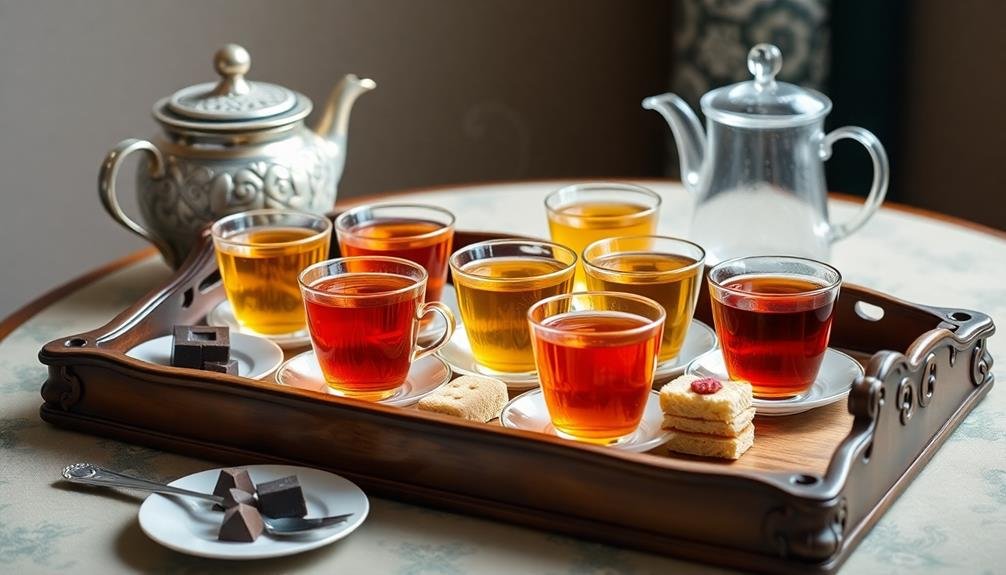
While many people focus on wine pairings, tea can be an equally exciting companion to various foods. When pairing tea with food, consider the tea's flavor profile, intensity, and how it complements or contrasts with your dish.
Light, delicate teas like white or green teas pair well with subtle flavors, such as seafood or light salads. Robust black teas can stand up to heartier meals, including red meats and rich desserts.
Here are some classic tea and food pairings to try:
- Green tea with sushi or light vegetable dishes
- Oolong tea with roasted poultry or mild cheeses
- Black tea with strong-flavored meats or chocolate desserts
Don't be afraid to experiment with unexpected combinations. For example, a smoky Lapsang Souchong can add depth to grilled meats, while a floral Jasmine tea can enhance fruit-based desserts.
Remember that personal preference plays a significant role in pairing success. Trust your palate and be open to discovering new flavor combinations.
Creating Your Tea Tasting Journal
Starting a tea tasting journal is an excellent way to enhance your appreciation and understanding of different teas.
It'll help you track your experiences, develop your palate, and remember your favorite brews. To create your journal, choose a format that works for you—whether it's a physical notebook or a digital app.
For each tea entry, record essential details like the tea's name, type, origin, and brewing method. Note the tea's appearance, both dry and steeped. Describe the aroma, focusing on specific scents you detect.
When tasting, pay attention to the flavor profile, body, and aftertaste. Use descriptive words to capture the tea's unique characteristics.
Don't forget to include your personal ratings and any additional thoughts or observations. You might want to note the time of day, your mood, or any food pairings.
As you build your journal, you'll start to recognize patterns in your preferences and develop a more nuanced understanding of different tea varieties.
Consider adding photos or pressed tea leaves to make your journal more visually appealing and memorable.
Over time, your tea tasting journal will become a valuable resource for your tea journey.
Frequently Asked Questions
How Long Does It Take to Develop a Refined Tea Palate?
You'll develop a refined tea palate gradually over time. It can take months or even years of consistent tasting and practice. You're constantly learning, so be patient and enjoy the journey of exploring different teas.
Can Medication Affect the Way Tea Tastes?
Yes, medication can affect how tea tastes. You'll notice some drugs alter your taste buds, causing flavors to seem different. It's not uncommon for medicines to leave a metallic taste or make certain foods less appealing.
Are There Professional Tea Tasting Certifications Available?
Yes, you'll find professional tea tasting certifications available. You can pursue courses from organizations like the Tea Association of the USA or the UK Tea Academy. They'll teach you advanced tasting techniques and industry standards.
How Do Tea Tasting Competitions Work?
You'll find tea tasting competitions involve blind sampling, where you'll evaluate teas based on appearance, aroma, flavor, and mouthfeel. You'll score each tea and discuss your findings with other judges to determine winners in various categories.
What Role Does Water Quality Play in Tea Tasting?
Water quality's essential for tea tasting. You'll notice how it impacts flavor, aroma, and clarity. It's best to use filtered or spring water. Hard water can dull flavors, while soft water enhances subtleties. Don't overlook this key factor!
In Summary
You've now got the essentials to commence your tea-tasting journey. Armed with the right equipment, techniques, and knowledge, you'll reveal a world of flavors. Don't forget to experiment with different teas, steeping methods, and food pairings. Keep your palate open and your journal handy. With practice, you'll develop a deeper appreciation for tea's nuances and complexities. So brew up a cup, sip mindfully, and enjoy the adventure of discovering your perfect brew.


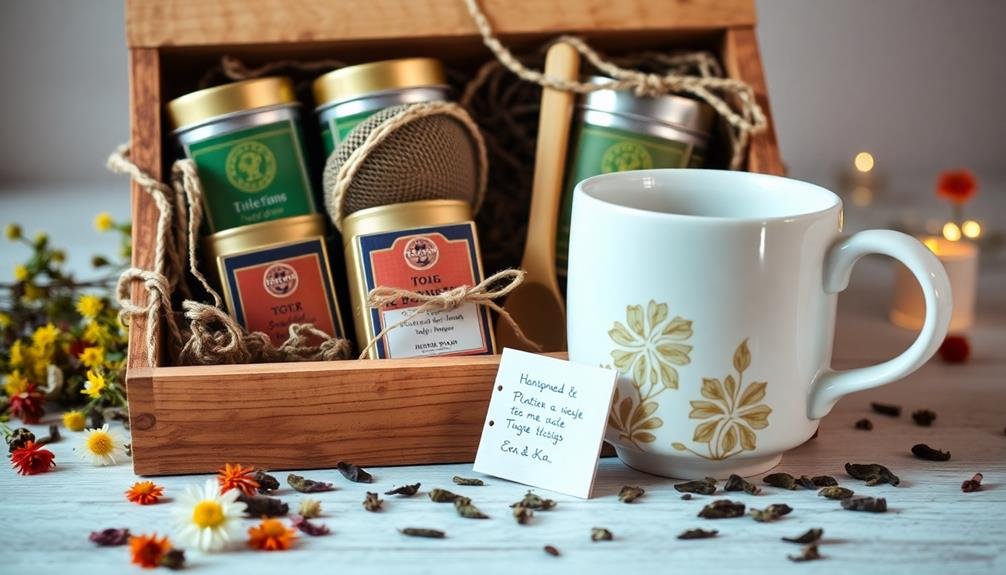
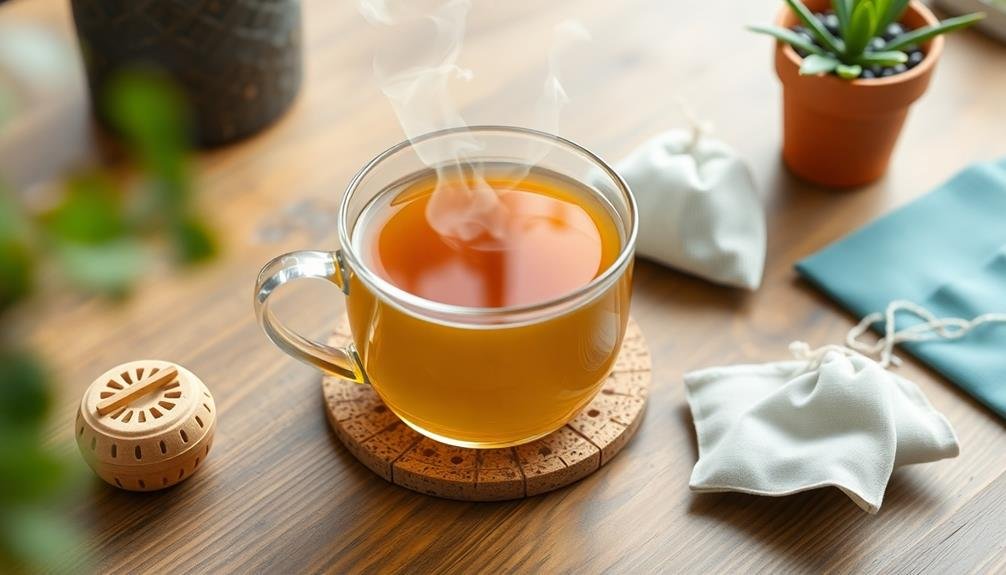
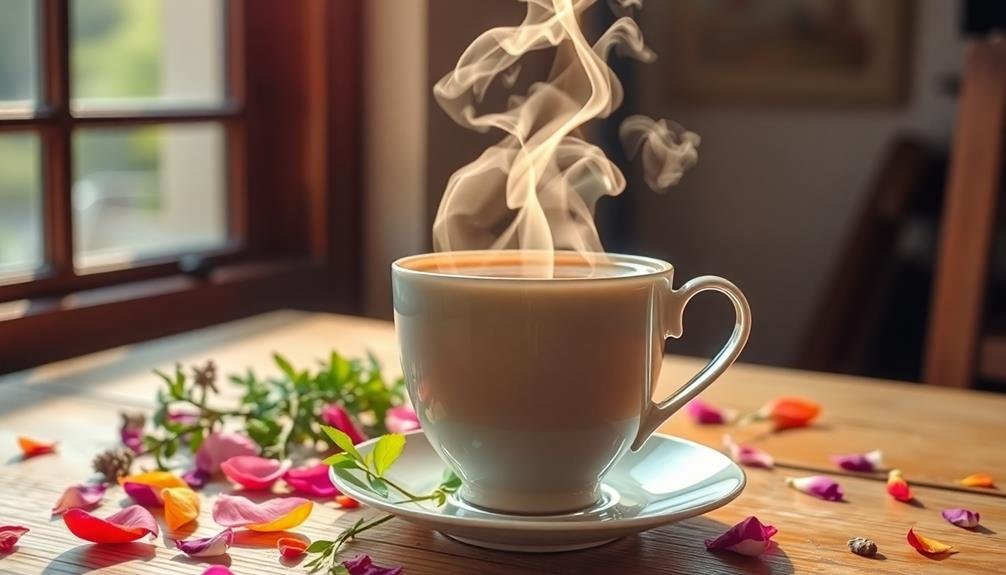
Leave a Reply